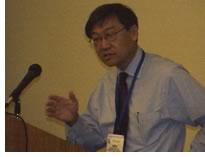

Profession Grapples with “Arrested Development”
Moderator Clark Kellogg, associate partner and director of strategic services for Gordon Chong + Partners, San Francisco, was just hitting his stride Friday morning. With a wink, he confessed to the 150+ attendees at his seminar that, although not licensed in California, he sometimes identifies himself as an architect anyway. And then it happened.
Two detectives burst into the room, booming, “You’re under arrest for impersonating an architect!”
“I’m an expanded architect,” Kellogg protested.
“Well, we’re expanded detectives,” they said as they handcuffed him and dragged him from the room.
 Funny,
yes, but the topic panelists confronted during “The Architect of
an Expanding Profession” posed a serious question. Gordon H. Chong,
FAIA; Tom Fisher, Assoc. AIA, dean of the University of Minnesota’s
College of Architecture; and Elizabeth Koski, Assoc. AIA, of Jakobs, Chicago,
set out to craft a single, new definition of the term “architect”
and, hence, of the profession. The AIA National Associates Committee and
ArchVoices sponsored the session.
Funny,
yes, but the topic panelists confronted during “The Architect of
an Expanding Profession” posed a serious question. Gordon H. Chong,
FAIA; Tom Fisher, Assoc. AIA, dean of the University of Minnesota’s
College of Architecture; and Elizabeth Koski, Assoc. AIA, of Jakobs, Chicago,
set out to craft a single, new definition of the term “architect”
and, hence, of the profession. The AIA National Associates Committee and
ArchVoices sponsored the session.
“Our task is to look at the definition of the word ‘architect,’ think it through, and bring new meaning and clarity to the word,” Kellogg said before he was hauled off. Chong, picking up where his partner left off, said, “Defining ourselves for 150 years according to strict standards now inhibits what we do.”
An expanded professional
Each of the panelists supplied a definition to get the conversation going.
Chong was careful to note that, with his contribution, he wasn’t
“redefining, but expanding on what our profession is all about.”
His view of an architect: “A master designer of ideas and processes
uniquely capable of rational and intuitive thought and action to benefit
the built environment.”
 Chong
pointed to a comparison between 1990 and 2000 firm-survey findings that
showed that while net firm revenues grew 136 percent and demand for basic
services increased 86 percent, demand for expanded services jumped 313
percent beyond the “should-we?” phase and into the “how-to.”
Chong
pointed to a comparison between 1990 and 2000 firm-survey findings that
showed that while net firm revenues grew 136 percent and demand for basic
services increased 86 percent, demand for expanded services jumped 313
percent beyond the “should-we?” phase and into the “how-to.”
He pointed to several characteristics inherent in an expanded profession:
• A bigger definition of education, reliant on interdisciplinary
and integrated study. This moves beyond the expected into the study of
such subjects as sociology, anthropology, finance, and economics
• Varied career settings
• More reinvention, innovation, and exploration
• Design ethics based on community standards, not those of clients.
“An integrator of arts, science,
and economics”
Kosti offered a simpler, more direct take on “architect,”
though one very complex in the making: “An integrator of the art,
science, and economics of the built environment.” Later, attendees
added sociology and psychology to the fields to be included. “It
is taking architecture beyond a single form in a landscape,” she
commented later.
Kosti saluted the American Institute of Architecture Students for a recent examination of the studio culture that continues to force questions that need to be answered concerning such things as leadership, community engagement, work/life, diversity, and innovation in alternative learning methods.
A graduate of architecture school
Fisher picked up the “alternative” mantra and provided historical
context beyond the 150 years of the established profession, noting, “What
we do now is more atypical than typical.” He pointed to Greece,
Rome, the Middle Ages, and the Renaissance as periods where the practice
of architecture moved freely among other fields. “Alternative paths
have a long tradition in our profession,” he said.
He noted that some 50 percent of graduates of architecture schools will end up in an alternative career, primarily in the areas of construction; digital design and software development; owner/client roles; and intellectual pursuits such as education, criticism, and research. Later in the seminar, about 10 percent of the audience identified themselves as specializing in an area outside the tradition definition.
Fisher’s new definition was the most aggressive, even giving him pause: “Any person who has graduated from an accredited architecture school regardless of what he or she does with the education.” Later in the program, he admitted, “This plays into the hands of anyone who wants to deconstruct the profession,” referring to the anything-goes era that preceded and, in fact, spurred the movement 150 years ago that gave rise to today’s strictly defined profession.
Kellogg, now sprung from his “incarceration,” cited the fairly broad agreement and let the three definitions stand as the beginning of the new definition. But Chong reminded everyone, “When you begin to define, you begin to limit.”
Copyright 2003 The American Institute of Architects.
All rights reserved. Home Page ![]()
![]()
 |
||
|
|
||